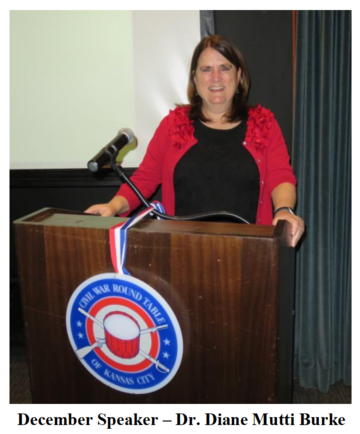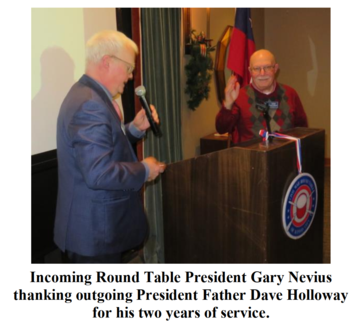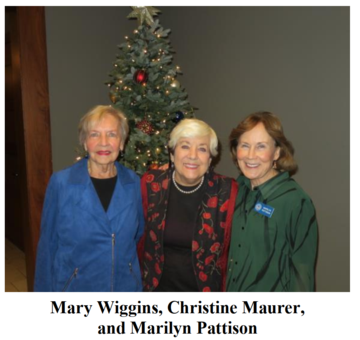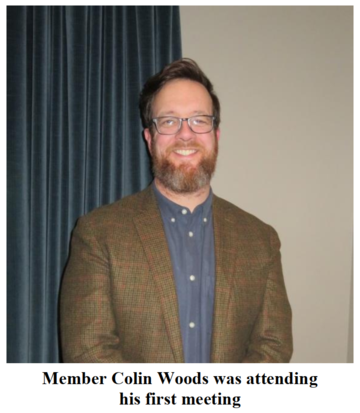December 2023 Meeting

At the dinner meeting on December 13th, Dr. Diane Mutti Burke, Professor of History at the University of Missouri-Kansas City (UMKC), gave a very interesting presentation titled: “Scattered to the Four Winds of the Earth”, The Civilian Refugee Crisis in the American Civil War. Total attendance at the meeting was 59.
The following is a detailed summary of Dr. Mutti Burke’s presentation:
Dr. Mutti Burke said she plans to write a book about the Civilian Refugee Crisis in the American Civil War. She has been doing preliminary research for ten years. However, she got sidetracked when she was made Chair of the History Department at UMKC.
On August 25, 1863, Union General Thomas Ewing issued General Order No. 11. This resulted in the eviction of citizens from four Missouri counties: Jackson, Cass, Bates, and Vernon counties. All citizens were removed, except for those who were loyal to the Union. Those who could prove their loyalty had to move within a mile of Union camps. The forced exit of civilians was one of the most dramatic and egregious actions of the Civil War. Dr. Mutti Burke said a lot of people in the U.S. don’t know what happened here.
Dr. Mutti Burke wanted to look at refugees as a whole, including those who lived outside of Missouri. Order No. 11 was a small piece of what took place during the Civil War. She is not focused as much on refugees due to the war (campaigns, battles, etc.) In general, she found that poor, white, and indigenous peoples were displaced.
Refugees throughout the south were where there was a high concentration of troops, divided loyalties, and political violence. People were displaced in the border states and throughout the south. The refugee crisis resulted from displaced civilian populations in the south and the Indian Territory (Oklahoma).
Foe those people who were forced out of their homes, what happened to them? People left. White women, children, and the elderly were left to tend to their households and farms. Indigenous people and enslaved people faced other hardships. They were not accepted or welcomed.
Factors affecting refugees:
- Movement of the armies.
- Death and destruction.
- Occupation of territory.
- Confiscation of properties,
- Political loyalties (guerrilla bands vs. Union troops).
Many slaves fled to the Union troops. However, for many slaves, escaping was fraught with danger.
Where were the refugees relocated? How did they get there? Who assisted them? Some headed west. Some got aide from family members or the kindness of strangers. People were afraid to help people of different political persuasion. Refugees moved to Texas, Indiana, and Illinois. Many went to cities for safety and employment. Many moved away for the duration of the war.
Indigenous people were not welcome. Soldiers helped some indigenous people. The crisis was so acute that the Federal Government ended up helping displaced people. Displaced whites were treated better than slaves or indigenous people.
When refugees went back home, they found their houses destroyed and their enslaved workers gone. They had to rebuild or move on. Free people had to find work in nearby cities or go west for settlement. They had to deal with violence and the taking of their land.
Dr. Mutti Burke said she did research at the National Archives in New York City on seven former slave states (MO, AR, KY, WV, VA, MD, SC) and the District of Columbia. She found a lot of reports made by the U.S. Sanitary Commission regarding refugees. Dr. Mutti Burke said she just scratched the surface in her research.
The refugee situation in Missouri was one of the most acute. Refugees reached Missouri before other areas of the south. People were displaced from the border area. The Civil War became a “hard war” due to the KansasMissouri border conflict.
The state of Missouri was conflicted in 1861. People could maintain their lifestyle if Missouri stayed in the Union. Claiborne Fox Jackson was elected as the 15th governor of Missouri and served from January 3, 1861 until July 31, 1861, when he was forced out by the Unionist majority in the legislature, after planning to force secession of the state. In the fall of 1861, Jackson started a pro-Confederate secessionist government and was pushed into northern Arkansas. Missouri remained under the control of Union troops.
Hostilities continued from Bleeding Kansas between Kansas troops and Missouri guerrillas. Many Missouri men joined the Confederate, militia, and guerrilla forces. They stole from people they didn’t agree with.
Refugees consisting of whites, indigenous, and enslaved people began being displaced in the spring and summer of 1861. Hundreds of Missouri Unionists were pushed into Kansas. In southwest Missouri and northern Arkansas, they headed to St. Louis. In the spring and summer of 1861, Unionists were pushed out of Missouri, especially after the Battle of Wilson’s Creek, which was a Confederate victory.
Once Union forces took control of Missouri, they had to maintain control. The Missouri countryside belonged to the Missouri guerrillas. Local secessionists provided aid to the guerrillas. The Union Army established Martial Law in 1861. Missourians had to take an oath of loyalty. They had to provide aide to the Union. If they owned slaves, they were considered to be disloyal to the Union.
It was not unheard of for secessionists to be shot or hung without the right of a fair trial. Irregular Jayhawk units held resentments against Missouri guerrillas. Jennison’s Jayhawkers served during the fall and winter of 1861-1862 in western Missouri, during which time they made frequent raids and stole livestock, freed slaves, etc.
Missouri Confederate bushwhackers pointed to the Union units as the reason they joined the guerrillas. They hit the Union forces and then went back into the brush. Their attacks were just as brutal at the Jayhawkers’. The guerrillas were ruthless. They hung men and burned their homes.
The conflict decimated farms in Missouri. Fields were barren, homes burned, livestock run off, and slaves gone. No one escaped the destruction. Farmers had so little to give. Men and boys hid in the woods to preserve their livestock. It was difficult to farm under those circumstances. Men left women and children at home. Many fled under cover of night and joined the guerrilla fighters or headed to cities like St. Louis. They headed to Iowa, Illinois, Indiana, Arkansas, and Kentucky. They also headed west due to the 1862 Homestead Act and the prospect of mining in Colorado. Many headed west to avoid the Union Draft. Many men and women headed west during the Civil War. They were left with no other option and they suffered grave economic loss by abandoning their property.
Starting in the summer of 1861, enslaved people saw an opportunity to escape slavery. Free slaves escaped to Kansas or to Union troops. A lot of Missouri Unionists owned slaves. A few Missourians reclaimed their slaves. They could refugee their slaves by moving them to the deep south in Texas.
Once refugees made the decision to leave, they had little time to prepare. They moved to be with family and friends or wherever they could get aide. It was very risky and dangerous. Women and children traveled overland. It was difficult for secessionists who had to get through the Union lines. It was safer to travel in numbers. But it was difficult to get help. If someone helped the wrong people, they could be retaliated against.
It was difficult for slave owners to maintain the slaves on their farms. The slaves had to be locked up at night. Bushwhackers were particularly brutal. In the fall of 1863, enslaved people traveled at night to get to Union lines. Unionists and contraband could get assistance from Union troops. Union officers asked for resources to help the refugees (women, children, and the elderly). The refugees overwhelmed the Union camps. There was a lack of food and shelter. One solution was to put people to work in the Union camps.
In 1862, Kansas Senator James Lane recruited colored troops. However, African-American recruitment made it more difficult to help enslaved people.
Most refugees made it to safety, but others found that problems were still following them. They were not welcome due to political disagreements. Few Missourians were willing to help women. They stole their possessions. However, the guerrilla forces couldn’t be effective without help from Missouri women.
General Ewing made the decision to evict citizens from the border. The District of the Border was established. Ewing had a list of guerrilla women and by mid-summer of 1863 the Union began arresting women. On August 13, 1863 a makeshift prison in Kansas City, which held some guerrilla women, collapsed. Quantrill’s Raid on Lawrence KS took place on August 21, 1863. A total of 160-180 men were killed and the town was torched. Ewing issued Order No. 11 on August 25, 1863. Ewing thought the best chance to eliminate violence was to evacuate Jackson, Cass, Bates, and Vernon counties.

Union soldiers burned farms and homes and confiscated livestock. Martial Law was established. The summer of 1863 was very hot for women, children, and the elderly heading south. Confederate sympathizers fled to Texas, Iowa, Illinois, Indiana, and California.
General Ewing’s Order No. 11 was rescinded in January 1864. However, vast stretches of western Missouri were desolated. This area became known as the “Burnt District.” There is a monument to the “Burnt District” in Harrisonville MO. The population of western Missouri dwindled to those that could get protection from the Union army. General Order No. 11 resulted in the unprecedented eviction of civilians. It resulted from a decade of bad blood. August of 1863 was the culmination of years of displacement.
On March 3, 1865, Congress passed “An Act to establish a Bureau for the Relief of Freedmen and Refugees” to provide food, shelter, clothing, medical services, and land to displaced Southerners, including newly freed African Americans.
Members Attending the Meeting




